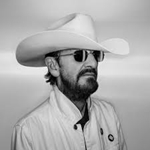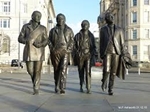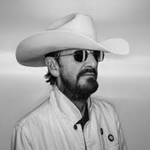- Register
- Log in to Tune-In
- Wishlist (0)
-
Shopping cart
(0)
You have no items in your shopping cart.
Beatles News

Ringo Starr has a secure place in music history as a member of the Beatles, but the legendary drummer and singer isn’t resting on his laurels.
Starr, 84, is releasing a country album, “Look Up,” on Jan. 10, 2025. The first single from the project, “Time On My Hands,” was released on Oct. 18, featuring Starr’s distinctive vocals. (Listen to the song in a lyric video below.)
Grammy winner T Bone Burnett, a roots music powerhouse, was Starr’s primary collaborator on the album, producing all 11 tracks and writing or co-writing most of them. It’s Starr’s first full-length album since 2019, and the followup to a 1970 record with strong country influences, “Beaucoups of Blues.”
“I’ve always loved country music,” Starr said via a press release. “And when I asked T Bone to write me a song, I didn’t even think at the time that it would be a country song — but of course it was, and it was so beautiful. I had been making EPs at the time and so I thought we would do a country EP — but when he brought me nine songs I knew we had to make an album. And I am so glad we did. I want to thank, and send Peace & Lov details

It’s a pretty big stretch to call any of The Beatles’ songs “underrated.” That being said, there are a few tracks here and there from the Fab Four’s discography that rarely get widespread praise. We think they’re worth a listen or two. Let’s take a look at four of the most underrated songs by The Beatles!
The 1967 B-side to “All You Need Is Love” was obviously overshadowed by the hit it was released with. Still, “Baby You’re A Rich Man” deserves more love than it has gotten. It’s a fantastic mutual collaboration between John Lennon and Paul McCartney, with a psychedelic energy to it that stands out.
It’s loaded with effects, synth sounds, and a beefy chorus that you won’t find in many of the Fab Four’s other songs from that era. Allegedly, Mick Jagger of The Rolling Stones contributed some backing vocals to the track. Though, that’s never been confirmed.
Source: American Songwriter
details
John Lennon and Yoko Ono's relationship had many ups and downs. One of those downs was the time that Lennon had sex with another woman at a party while Yoko was able to hear them. This ended up in their break up, which eventually left Lennon feeling miserable. Thankfully, Paul McCartney was there for Lennon, which led to him reuniting with Yoko years after their breakup.
This whole relationship drama was narrated by Elliot Mintz, a close friend of Lennon and Yoko's. Mintz talked about the couple's mishaps in his memoir, "We All Shine On: John, Yoko, and Me."
Described as "loud, raucous sex," the whole breakup was triggered after Lennon's infidelity with a woman during a Jerry Rubin party in 1972. "Throughout it all, Yoko sat on the sofa, in stunned, mortified silence, as other guests began awkwardly getting up to leave — until they realized that their coats were in the bedroom where John was having sex," Mintz wrote, according to Fox News.
From New York To Los Angeles
After Lennon's infidelity, he started a relationship with May Pang in 1973. While Mintz believes Yoko never arranged the relationship, Pang has stated that Yoko "took advantage" of her and set the whole thing up. Lennon and Pang details

The Beatles made music that transcended their generation, touching lives for decades to come. There’s more than a hint of the uncanny in their work at times – layers of hidden meaning that seem to touch on unmasked areas of the subconscious.
Still, when the band reconvened in the mid 90s they could scarcely have imagined how deeply it would affect them. Paul McCartney, George Harrison, and Ringo Starr were gifted a cassette by Yoko Ono, featuring home made demos recorded by the late John Lennon.
Deciding to record two of these for the Anthology project, the trio worked alongside producer Jeff Lynne on ‘Free As A Bird’ and ‘Real Love’.
Right from the start, the reconvened group knew how difficult it would be to measure up their illustrious past – especially without John Lennon in tow. Paul McCartney explained…
“She was there with Sean … and she played us a couple of tracks. There were two newies on mono cassettes which he did at home … [s]o I checked it out with Sean, because I didn’t want him to have a problem with it. He said, “Well, it’ll be weird hearing a dead guy on lead vocal. But give it a try.” I details

Paul McCartney, former member of The Beatles, will perform live in Costa Rica on November 5, 2024, as part of his highly anticipated Got Back tour. McCartney fans can look forward to his first Costa Rican concert in nearly a decade, following his unforgettable 2014 show. Before the concert, the music legend will take time to explore the natural beauty of Costa Rica.
The legendary musician will arrive in Costa Rica a few days prior to his concert on a private flight. While the destinations McCartney plans to visit remain undisclosed, concert producers have confirmed that he is eager to experience the country’s natural wonders, including its beaches and volcanoes.
McCartney first performed in Costa Rica in 2014, and according to concert producers, he has been in love with the country ever since. This year, he plans to enjoy a brief holiday exploring the country’s most beautiful landmarks before taking the stage for his Got Back tour concert.
“We are arranging a tour of Costa Rica’s interior, showing Paul some of the most stunning sights the country has to offer. He’ll fall even more in love with Costa Rica than he did during his first visit,” said Andrés Guanipa, details

There never was nor could be another pop manager like Brian Epstein, the young record salesman from Liverpool who discovered The Beatles and with them changed the course of popular music and culture for ever.
When Brian took them on in 1962, no one could understand his faith in what seemed the weirdest of pop groups with their fringed foreheads, eccentric repertoire (from Chuck Berry to Fats Waller) and left-handed bass player whose instrument resembled a violin mated with a giraffe.
His declaration that one day they'd be 'bigger than Elvis Presley', then the ultimate pop superstar, was met with pitying smiles.
But he was way off beam: after only two years in his hands, they'd be bigger than any earthly instrument could measure. Pop artists' managers until then had been a nondescript bunch, known to the public – if indeed they were – for ruthlessly exploiting and defrauding their naive young proteges.
Brian was of an utterly different stamp, with his immaculate tailoring, 'BBC accent' and old-fashioned insistence on honouring agreements and giving value for money.
Now his monumentally successful but hauntingly sad life has inspired a biopic titled Midas Man – after the m details

It is hoped the new artwork could emulate the popularity of the Beatles sculpture at Liverpool's Pier Head.
A competition has been launched to design a landmark Beatles-inspired artwork outside a venue where the band performed 27 times.
Artists in the Liverpool City Region are being invited to pitch ideas for a sculpture at Tower Ground in New Brighton to celebrate the Wirral town's links to the Fab Four.
The former Tower Ballroom was the venue where the band staged their most performances - apart from their spiritual home at Liverpool’s famous Cavern Club.
Competition organisers's vision is for the sculpture, which should be at least two metres (6.5ft) tall, to be viewed from the River Mersey.
On the other side of the water, the Beatles statue on Liverpool's Pier Head - designed by Andrew Edwards and contributed by the Cavern Club - has become one of the city’s most popular selfie spots since its installation in 2015.
Grants will be offered for shortlisted applicants to develop the work for Tower Ground. Funding has been provided by local authorities and firms after Wirral became the 2024 Borough of Culture.
Source: bbc.com
details
In one of his last interviews, John Lennon reminded legions of fans that when it comes to his work with The Beatles—and, by extrapolation, his solo efforts—the music will always be the thing that matters most. Indeed, it will be Lennon and The Beatles’ musical achievements that go down through the centuries. The rest, frankly, is just noise.
With "We All Shine On: John, Yoko & Me," author and publicist Elliot Mintz fashions a heartbreaking portrait of Lennon’s life and times beyond the recording studio. In so doing, he explores the reality behind the effort that it required for artists such as Lennon to find their mettle as musicians. In this sense, Mintz’s memoir is not for the faint of heart. The psychological toll of Lennon’s addictions is palpable, as is the personal toil that was required for him to will yet another album into being. As Mintz’s book makes indelibly clear, the cost that it exacted upon the songwriter’s relationships was considerable.
As a California DJ and television personality in the early 1970s, Mintz found himself in Lennon’s orbit during an era in which rock ‘n’ roll was gingerly feeling its way after the majesty and details

Few bands have left a mark on music history quite like Paul McCartney and Wings. After the monumental success of The Beatles, McCartney formed Wings in 1971, embarking on a new chapter filled with unforgettable melodies, groundbreaking hits, and timeless anthems. Blending rock, pop, and a touch of McCartney’s signature soulful ballads, Wings became one of the most successful bands of the 1970s, delivering hit after hit that still resonates with fans today. Whether you’re a lifelong fan or just discovering their magic, this countdown of the top 10 most popular Paul McCartney and Wings songs is sure to remind you why their music continues to inspire generations. From soaring harmonies to irresistible hooks, each track in this list showcases McCartney’s genius for songwriting and his undeniable ability to craft songs that stay with you long after the music stops. So turn up the volume, settle in, and let’s take a thrilling flight through Wings’ most iconic songs—guaranteed to make you feel like you’re hearing them for the first time all over again!
1. “Band on the Run” (1973)
2. “Live and Let Die” (1973)
3. “Jet” (1973)
4. &ldqu
details

Paul McCartney has rarely taken time off. In fact, well into his 80s, the former Beatle and rock star still tours semi-regularly and knows how to put on one heck of a live show. Surprisingly, though, there was a time when McCartney really didn’t feel like performing live. And we’re not talking about The Beatles’ inevitable retirement from live music, several years before they officially broke up. Rather, we’re talking about a 10-year period from 1979 to 1989 in which McCartney refused to tour.
In a way, we understand where he was coming from. The Beatles’ tours were intense, to say the least. Few live performances from The Beatles’ past are completely audible over all the shrieking. McCartney even openly admitted that he was not a fan of live performances, even with Wings.
“It had been sort of brewing, this distaste for schlepping around and playing in the rain with the danger of electricity killing you,” McCartney once said in an interview. “You kind of just look at yourself and go, ‘Wait a minute, I’m a musician, you know. I’m not a rag doll for children to scream at.’”
When Wings wrapped up their final UK tour in 1979, details

Love can move us in mysterious ways. As the saying goes, only fools fall in love. But, what comes first the foolery or the love? In our experience, it’s the latter that sends us into a dizzying tail spin, making us act against our better judgement. Not even famous rock stars are immune to love’s effects. If you need proof of that, revisit the time George Harrison and Eric Clapton had a guitar duel over Pattie Boyd, below.
Harrison and Clapton started their relationship as friends and musical colleagues. That friendship shifted when Clapton began to have eyes for Harrison’s partner, Boyd. His infatuation for her can be felt in the caustic and blushing “Layla.” The eruption of emotion in that track makes it very clear that Clapton was head over heals for Boyd.
Clapton eventually won Boyd and the two rockers worked out their differences. Though Harrison and Clapton remained friends until the Beatle’s death, there were moments when their relationship was strained. Boyd once talked about the time the musicians let their love get the best of them.
Source: Alex Hopper/americansongwriter.com

Diehard Beatles fans know the “fifth” Beatle George Martin all too well. More chill fans may not be in the loop. For the uninformed, Martin was the main producer behind the vast majority of the Fab Four’s music. He was with the band when they were nobodies and stayed with them until the end. He was pretty vocal about how much he loved the majority of The Beatles’ music. However, there were a few tracks here and there that he didn’t love. Let’s look at four Beatles songs that George Martin said he wasn’t a fan of!
1. “Within You Without You”
This George Harrison-penned 1967 track from Sgt. Pepper’s Lonely Hearts Club Band is a pretty great song, but it wasn’t George Martin’s favorite. It wasn’t Harrison’s favorite, either. Harrison admitted that his “heart was still in India” upon returning from a trip there, and he was struggling to come up with inspired music. That much is, unfortunately, evident in “Within You Without You”. Martin described it as a “rather dreary song” that was a bit hamfisted with the Indian classical inspirations from Harrison.
Source: Em Casalena/American Songwriter details

The pressure on Paul McCartney to deliver some kind of statement in song summing up his feelings about John Lennon’s death must have been immense. How easily he could have misjudged the task and come up with something Lennon himself likely would have criticized as sappy.
McCartney managed to sidestep all of that by taking an honest look at his relationship with his ex-partner in the 1982 song “Here Today.” In so doing, he ended up delivering perhaps the most touching tribute of all to Lennon.
How could a songwriter possibly address a situation as tragic as the sudden, senseless death of John Lennon? Many did, and some did so quite admirably. (Elton John/Bernie Taupin, Paul Simon, and another Beatle, George Harrison, come to mind.) But expecting Paul McCartney to do it was another story.
Of course, McCartney is one of the finest songwriters of any era, so his skill was never the question. But because the whole world knew him as one half of the greatest writing team of all time—with Lennon being the other half—it was never going to be easy to put all that into words. And the public also knew well the two men weren’t always on the best of terms, especially after The Beat details

This week, Ringo Starr announced his return to country music with a brand-new album, Look Up, produced by T Bone Burnett. Following the release of his latest single, "Time on My Hands," Starr has shared several teasers on social media, including images from the album art photoshoot.
In a true meeting of Genesis authors, the concept for the album was born at the Sunset Marquis book launch for Olivia Harrison's Came the Lightening: Twenty Poems for George, where Starr met Burnett. There, they discussed their shared love of country music and agreed to collaborate on the project.
"I thought Ringo was deserving of a serious album... Occasionally, you catch a glimpse of what somebody can mean now who had an illustrious past, and something that doesn't have to do with the charts and all that stuff, but just has to do with the timelessness of who they are." - T Bone Burnett
Featuring the talents of Billy Strings, Molly Tuttle, Larkin Poe, Lucius, and Alison Krauss, these artists are said to bring fresh and exciting energy to the eleven tracks, making substantial contributions to the album's overall sound.
Now shipping worldwide, below you can learn more about the new signed prints in Ringo Starr's Photog details

Luther Vandross’ Cover of The Beatles’ “Michelle” Released: “Another Classic Song Has Been Lutherized!”
The release coincides with the documentary 'Luther: Never Too Much,' which opens in select cities on Nov. 1. The 'Never Too Much: Greatest Hits' album is out on Dec. 13.
Luther Vandross passed away in 2005, but unreleased music from the R&B icon was made available Friday — a cover of The Beatles’ ‘60s hit “Michelle.”
Vandross’ close friend and vocal collaborator, Fonzi Thornton, discovered the tape following the singer’s death when he visited his family to look through his music archives, unseen videos, cassette tapes, personal effects, stage costumes and more. He then moved the archives to a room in his apartment for safekeeping.
“I found two cassettes labeled ‘Michelle’ in his handwriting — [I had] no idea what it was [and then I] played it! I realized it was a beautiful rendition of the Beatles classic that had been vocally and musically Lutherized,” Thornton tells The Hollywood Reporter. “I played Luther’s version for Jeff James, A&R at Sony and D details
